+ データを開く
データを開く
- 基本情報
基本情報
| 登録情報 | データベース: PDB / ID: 6wdt | |||||||||||||||
|---|---|---|---|---|---|---|---|---|---|---|---|---|---|---|---|---|
| タイトル | Enterovirus D68 in complex with human monoclonal antibody EV68-228 | |||||||||||||||
 要素 要素 |
| |||||||||||||||
 キーワード キーワード | VIRUS/IMMUNE SYSTEM / virus / enterovirus / antibody / Structural Genomics / Center for Structural Genomics of Infectious Diseases / CSGID / VIRUS-IMMUNE SYSTEM complex | |||||||||||||||
| 機能・相同性 |  機能・相同性情報 機能・相同性情報picornain 2A / symbiont-mediated suppression of host mRNA export from nucleus / symbiont genome entry into host cell via pore formation in plasma membrane / picornain 3C / T=pseudo3 icosahedral viral capsid / host cell cytoplasmic vesicle membrane / cytoplasmic vesicle membrane / endocytosis involved in viral entry into host cell / symbiont-mediated suppression of host gene expression / nucleoside-triphosphate phosphatase ...picornain 2A / symbiont-mediated suppression of host mRNA export from nucleus / symbiont genome entry into host cell via pore formation in plasma membrane / picornain 3C / T=pseudo3 icosahedral viral capsid / host cell cytoplasmic vesicle membrane / cytoplasmic vesicle membrane / endocytosis involved in viral entry into host cell / symbiont-mediated suppression of host gene expression / nucleoside-triphosphate phosphatase / channel activity / viral capsid / peptidase activity / monoatomic ion transmembrane transport / host cell cytoplasm / RNA helicase activity / symbiont-mediated suppression of host innate immune response / induction by virus of host autophagy / symbiont entry into host cell / RNA-directed RNA polymerase / viral RNA genome replication / cysteine-type endopeptidase activity / RNA-dependent RNA polymerase activity / virus-mediated perturbation of host defense response / DNA-templated transcription / host cell nucleus / virion attachment to host cell / structural molecule activity / ATP hydrolysis activity / proteolysis / RNA binding / ATP binding / metal ion binding / cytoplasm 類似検索 - 分子機能 | |||||||||||||||
| 生物種 |  Enterovirus D68 (エンテロウイルス) Enterovirus D68 (エンテロウイルス) Homo sapiens (ヒト) Homo sapiens (ヒト) | |||||||||||||||
| 手法 | 電子顕微鏡法 / 単粒子再構成法 / クライオ電子顕微鏡法 / 解像度: 3.1 Å | |||||||||||||||
 データ登録者 データ登録者 | Fu, J. / Vogt, M.R. / Klose, T. / Crowe, J.E. / Rossmann, M.G. / Kuhn, R.J. / Center for Structural Genomics of Infectious Diseases (CSGID) | |||||||||||||||
| 資金援助 |  米国, 4件 米国, 4件
| |||||||||||||||
 引用 引用 |  ジャーナル: Sci Immunol / 年: 2020 ジャーナル: Sci Immunol / 年: 2020タイトル: Human antibodies neutralize enterovirus D68 and protect against infection and paralytic disease. 著者: Matthew R Vogt / Jianing Fu / Nurgun Kose / Lauren E Williamson / Robin Bombardi / Ian Setliff / Ivelin S Georgiev / Thomas Klose / Michael G Rossmann / Yury A Bochkov / James E Gern / ...著者: Matthew R Vogt / Jianing Fu / Nurgun Kose / Lauren E Williamson / Robin Bombardi / Ian Setliff / Ivelin S Georgiev / Thomas Klose / Michael G Rossmann / Yury A Bochkov / James E Gern / Richard J Kuhn / James E Crowe /  要旨: Enterovirus D68 (EV-D68) causes outbreaks of respiratory illness, and there is increasing evidence that it causes outbreaks of acute flaccid myelitis (AFM). There are no licensed therapies to prevent ...Enterovirus D68 (EV-D68) causes outbreaks of respiratory illness, and there is increasing evidence that it causes outbreaks of acute flaccid myelitis (AFM). There are no licensed therapies to prevent or treat EV-D68 infection or AFM disease. We isolated a panel of EV-D68-reactive human monoclonal antibodies that recognize diverse antigenic variants from participants with prior infection. One potently neutralizing cross-reactive antibody, EV68-228, protected mice from respiratory and neurologic disease when given either before or after infection. Cryo-electron microscopy studies revealed that EV68-228 and another potently neutralizing antibody (EV68-159) bound around the fivefold or threefold axes of symmetry on virion particles, respectively. The structures suggest diverse mechanisms of action by these antibodies. The high potency and effectiveness observed in vivo suggest that antibodies are a mechanistic correlate of protection against AFM disease and are candidates for clinical use in humans with EV-D68 infection. | |||||||||||||||
| 履歴 |
|
- 構造の表示
構造の表示
| ムービー |
 ムービービューア ムービービューア |
|---|---|
| 構造ビューア | 分子:  Molmil Molmil Jmol/JSmol Jmol/JSmol |
- ダウンロードとリンク
ダウンロードとリンク
- ダウンロード
ダウンロード
| PDBx/mmCIF形式 |  6wdt.cif.gz 6wdt.cif.gz | 188 KB | 表示 |  PDBx/mmCIF形式 PDBx/mmCIF形式 |
|---|---|---|---|---|
| PDB形式 |  pdb6wdt.ent.gz pdb6wdt.ent.gz | 153.7 KB | 表示 |  PDB形式 PDB形式 |
| PDBx/mmJSON形式 |  6wdt.json.gz 6wdt.json.gz | ツリー表示 |  PDBx/mmJSON形式 PDBx/mmJSON形式 | |
| その他 |  その他のダウンロード その他のダウンロード |
-検証レポート
| 文書・要旨 |  6wdt_validation.pdf.gz 6wdt_validation.pdf.gz | 378.2 KB | 表示 |  wwPDB検証レポート wwPDB検証レポート |
|---|---|---|---|---|
| 文書・詳細版 |  6wdt_full_validation.pdf.gz 6wdt_full_validation.pdf.gz | 390.8 KB | 表示 | |
| XML形式データ |  6wdt_validation.xml.gz 6wdt_validation.xml.gz | 21.2 KB | 表示 | |
| CIF形式データ |  6wdt_validation.cif.gz 6wdt_validation.cif.gz | 32.4 KB | 表示 | |
| アーカイブディレクトリ |  https://data.pdbj.org/pub/pdb/validation_reports/wd/6wdt https://data.pdbj.org/pub/pdb/validation_reports/wd/6wdt ftp://data.pdbj.org/pub/pdb/validation_reports/wd/6wdt ftp://data.pdbj.org/pub/pdb/validation_reports/wd/6wdt | HTTPS FTP |
-関連構造データ
- リンク
リンク
- 集合体
集合体
| 登録構造単位 | 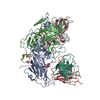
|
|---|---|
| 1 | x 60
|
| 2 |
|
| 3 | x 5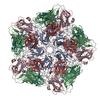
|
| 4 | x 6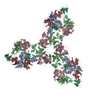
|
| 5 | 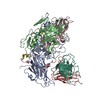
|
| 対称性 | 点対称性: (シェーンフリース記号: I (正20面体型対称)) |
- 要素
要素
-Viral protein ... , 4種, 4分子 ABCD
| #1: タンパク質 | 分子量: 32920.309 Da / 分子数: 1 / 断片: UNP residues 565-861 / 由来タイプ: 組換発現 由来: (組換発現)  Enterovirus D68 (エンテロウイルス) Enterovirus D68 (エンテロウイルス)株: US/MO/14-18047 / Cell (発現宿主): spindle / 細胞株 (発現宿主): RD / 発現宿主:  Homo sapiens (ヒト) / 組織 (発現宿主): muscle / 参照: UniProt: A0A097BW12 Homo sapiens (ヒト) / 組織 (発現宿主): muscle / 参照: UniProt: A0A097BW12 |
|---|---|
| #2: タンパク質 | 分子量: 27567.135 Da / 分子数: 1 / 断片: UNP residues 70-317 / 由来タイプ: 組換発現 由来: (組換発現)  Enterovirus D68 (エンテロウイルス) Enterovirus D68 (エンテロウイルス)株: US/MO/14-18047 / Cell (発現宿主): spindle / 細胞株 (発現宿主): RD / 発現宿主:  Homo sapiens (ヒト) / 組織 (発現宿主): muscle / 参照: UniProt: A0A0A7X639, UniProt: A0A097BW12*PLUS Homo sapiens (ヒト) / 組織 (発現宿主): muscle / 参照: UniProt: A0A0A7X639, UniProt: A0A097BW12*PLUS |
| #3: タンパク質 | 分子量: 27112.814 Da / 分子数: 1 / 断片: UNP residues 318-564 / 由来タイプ: 組換発現 由来: (組換発現)  Enterovirus D68 (エンテロウイルス) Enterovirus D68 (エンテロウイルス)株: US/MO/14-18047 / Cell (発現宿主): spindle / 細胞株 (発現宿主): RD / 発現宿主:  Homo sapiens (ヒト) / 組織 (発現宿主): muscle / 参照: UniProt: A0A097BW12 Homo sapiens (ヒト) / 組織 (発現宿主): muscle / 参照: UniProt: A0A097BW12 |
| #4: タンパク質 | 分子量: 7336.960 Da / 分子数: 1 / 断片: UNP residues 2-69 / 由来タイプ: 組換発現 由来: (組換発現)  Enterovirus D68 (エンテロウイルス) Enterovirus D68 (エンテロウイルス)株: US/MO/14-18047 / Cell (発現宿主): spindle / 細胞株 (発現宿主): RD / 発現宿主:  Homo sapiens (ヒト) / 組織 (発現宿主): muscle / 参照: UniProt: A0A126D252, UniProt: J9Z449*PLUS Homo sapiens (ヒト) / 組織 (発現宿主): muscle / 参照: UniProt: A0A126D252, UniProt: J9Z449*PLUS |
-抗体 , 2種, 2分子 HL
| #5: 抗体 | 分子量: 14037.602 Da / 分子数: 1 / 由来タイプ: 組換発現 / 由来: (組換発現)  Homo sapiens (ヒト) Homo sapiens (ヒト)発現宿主:  |
|---|---|
| #6: 抗体 | 分子量: 11354.635 Da / 分子数: 1 / 由来タイプ: 組換発現 / 由来: (組換発現)  Homo sapiens (ヒト) Homo sapiens (ヒト)発現宿主:  |
-実験情報
-実験
| 実験 | 手法: 電子顕微鏡法 |
|---|---|
| EM実験 | 試料の集合状態: PARTICLE / 3次元再構成法: 単粒子再構成法 |
- 試料調製
試料調製
| 構成要素 |
| ||||||||||||||||||||||||
|---|---|---|---|---|---|---|---|---|---|---|---|---|---|---|---|---|---|---|---|---|---|---|---|---|---|
| 分子量 | 実験値: NO | ||||||||||||||||||||||||
| 由来(天然) |
| ||||||||||||||||||||||||
| 由来(組換発現) |
| ||||||||||||||||||||||||
| ウイルスについての詳細 | 中空か: NO / エンベロープを持つか: NO / 単離: STRAIN / タイプ: VIRION | ||||||||||||||||||||||||
| 緩衝液 | pH: 8 | ||||||||||||||||||||||||
| 試料 | 包埋: NO / シャドウイング: NO / 染色: NO / 凍結: YES | ||||||||||||||||||||||||
| 試料支持 | グリッドの材料: COPPER / グリッドのサイズ: 400 divisions/in. | ||||||||||||||||||||||||
| 急速凍結 | 装置: GATAN CRYOPLUNGE 3 / 凍結剤: ETHANE |
- 電子顕微鏡撮影
電子顕微鏡撮影
| 実験機器 |  モデル: Titan Krios / 画像提供: FEI Company |
|---|---|
| 顕微鏡 | モデル: FEI TITAN KRIOS |
| 電子銃 | 電子線源:  FIELD EMISSION GUN / 加速電圧: 300 kV / 照射モード: FLOOD BEAM FIELD EMISSION GUN / 加速電圧: 300 kV / 照射モード: FLOOD BEAM |
| 電子レンズ | モード: BRIGHT FIELD / Cs: 2.7 mm / C2レンズ絞り径: 100 µm / アライメント法: ZEMLIN TABLEAU |
| 試料ホルダ | 凍結剤: NITROGEN 試料ホルダーモデル: FEI TITAN KRIOS AUTOGRID HOLDER |
| 撮影 | 平均露光時間: 2.6 sec. / 電子線照射量: 44.5 e/Å2 フィルム・検出器のモデル: GATAN K3 BIOQUANTUM (6k x 4k) 撮影したグリッド数: 1 / 実像数: 462 |
| 電子光学装置 | エネルギーフィルター名称: GIF Bioquantum / エネルギーフィルタースリット幅: 20 eV |
- 解析
解析
| ソフトウェア | 名称: PHENIX / バージョン: 1.16_3549: / 分類: 精密化 | ||||||||||||||||||||||||||||||
|---|---|---|---|---|---|---|---|---|---|---|---|---|---|---|---|---|---|---|---|---|---|---|---|---|---|---|---|---|---|---|---|
| EMソフトウェア |
| ||||||||||||||||||||||||||||||
| CTF補正 | タイプ: PHASE FLIPPING AND AMPLITUDE CORRECTION | ||||||||||||||||||||||||||||||
| 粒子像の選択 | 選択した粒子像数: 27390 | ||||||||||||||||||||||||||||||
| 対称性 | 点対称性: I (正20面体型対称) | ||||||||||||||||||||||||||||||
| 3次元再構成 | 解像度: 3.1 Å / 解像度の算出法: FSC 0.143 CUT-OFF / 粒子像の数: 20194 / アルゴリズム: FOURIER SPACE / 対称性のタイプ: POINT | ||||||||||||||||||||||||||||||
| 原子モデル構築 | プロトコル: RIGID BODY FIT / 空間: REAL | ||||||||||||||||||||||||||||||
| 原子モデル構築 | PDB-ID: 4WM8 | ||||||||||||||||||||||||||||||
| 拘束条件 |
|
 ムービー
ムービー コントローラー
コントローラー







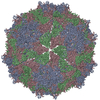

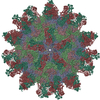
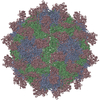
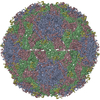
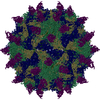
 PDBj
PDBj




